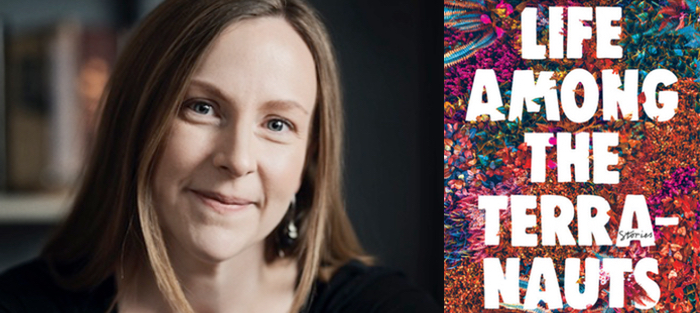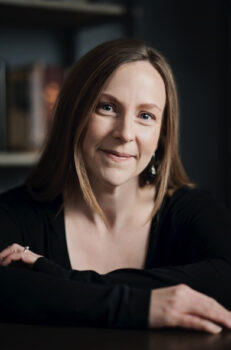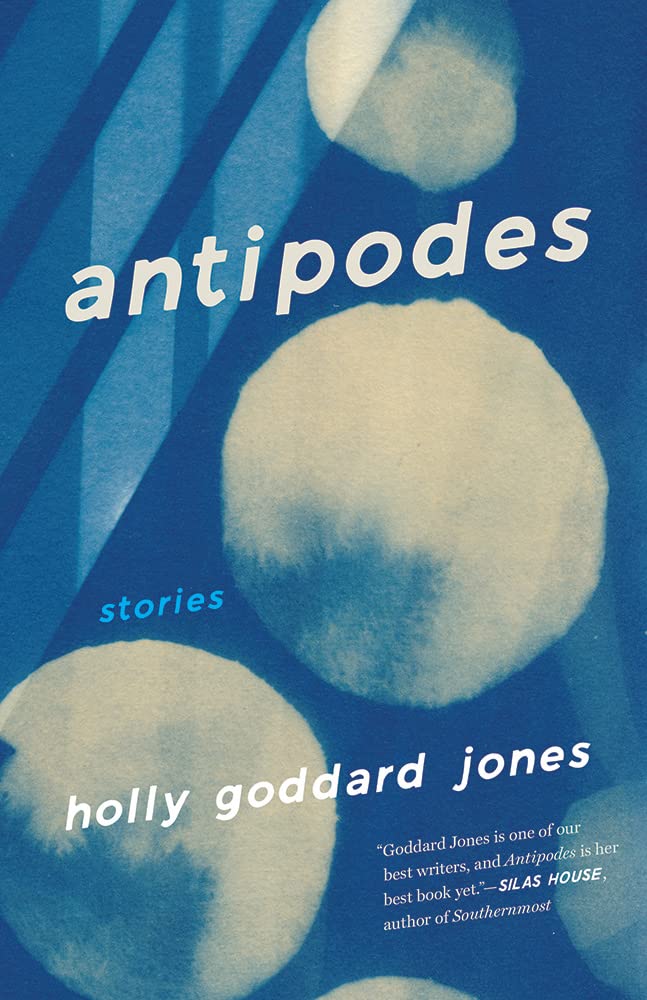The first time I encountered Caitlin Horrocks’s fiction was back in 2007, when she submitted what would become the title story for her debut collection, This is Not Your City, to Third Coast magazine, where I was an editor. The story, about a Russian mail order bride whose daughter has gone missing, was so captivating, so assured and wise, that we knew we had discovered more than a perfect story; we had happened upon what we suspected would be an enduring new voice. That story story went on to win an O. Henry. Since then, Horrocks has published a slew of masterful stories in such venerable magazines as The New Yorker, The Paris Review, Tin House, and One Story. In 2019, she released her debut novel, The Vexations, about French composer Erik Satie. Her second story collection, Life Among the Terranauts, released this January, shows a seasoned author at the height of her imaginative powers. These are deceptively quiet stories with big ideas hiding under the guise of the everyday. The book opens with her BASS prize-winning story, “The Sleep,” about a failing Midwestern community that decides to try to sleep through its grueling Midwestern winters. The pieces that follow offer one marvelous scenario after another, culminating in the final, title story that also features an isolated community. In “Life Among the Terranauts,” a group of researchers commit to living in a geodome for two years on the promise of a million-dollar prize. In this story, as in much of the book, suspense rises not just from the inherent tensions of communal living, but also from the hope that we humans might finally reinvent ourselves back from the brink.
Interview
Rachel Swearingen: “The Sleep,” the story that opens Life Among the Terranauts, features a family in a small Midwestern town that decides to hibernate through the winter, inviting the rest of the town to join them. I read it just after the election, amid the pandemic, with the days growing shorter. What struck me was how the story appears to be less about the dread of endless winters than about capitalism and the collapse of rural America. What inspired the story?
Caitlin Horrocks: The thing that inspired the story is the thing you’re (accurately) saying the story is no longer about—that is, my Midwestern winter dread. I’d read an article about historical sleep patterns, including possible human hibernation, and was moping around feeling grim about living where I live. The story’s origin was wish fulfillment. But within a few paragraphs the piece was already getting less cozy and more complicated. The questions I had to ask myself right off the bat—what would make hibernation physically or financially feasible? How would you arrange your life to make it possible, and what would you miss while you slept?—did not have particularly happy answers. Eventually I was asking questions less about individual lives than about the life of a community, about why we live where we live, how places sustain us (or don’t), or how we sustain them. Or how we strip them, and in that case, how we either move on or adapt to the aftermath.
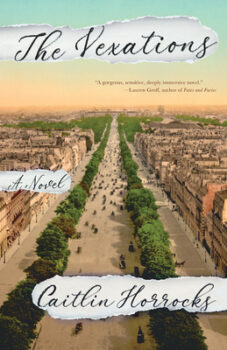 “How we either move on or adapt to the aftermath.” I love this statement. It could almost be a subtitle for the book as a whole. There’s a communal urgency in these new stories that isn’t as present in your first collection. Have your thoughts on the powers of the short story changed since writing This is Not Your City, and your novel The Vexations? What excites you about the form these days?
“How we either move on or adapt to the aftermath.” I love this statement. It could almost be a subtitle for the book as a whole. There’s a communal urgency in these new stories that isn’t as present in your first collection. Have your thoughts on the powers of the short story changed since writing This is Not Your City, and your novel The Vexations? What excites you about the form these days?
I think my feelings about the powers of the short story (vast, varied) have stayed the same, but I’ve maybe turned back to them with a renewed appreciation after spending so long in the world of The Vexations. I struggled with the transition to novel-writing for a long time, before finally arriving at the deeply un-surprising revelation that the longer I spent in the world of the novel, the easier it was to enter that world day after day. The way to write something is to write it, shockingly enough. But the work rarely felt playful in the way that stories do for me. Partly that was the subject matter, partly the fact that I sold the novel based on a partial draft, and so I was constantly aware of needing to complete something publishable and hopefully saleable. I’ve always loved the chance stories offer to try something new every five or fifteen pages, to purposefully challenge myself with something I haven’t done before. I’m more appreciative of that than ever.
It’s so true that stories allow for a kind of inventiveness and playfulness that is difficult to sustain in a novel. I can’t help but connect much of the playfulness in Life Among the Terranauts to the presence of children in the book. Although the more I think about this, the more I see this also in The Vexations. You appear to have an almost uncanny ability to tap into the wildness of childhood, even in the adults in your stories. What was your own childhood like? What interested you at, let’s say, ten? Did you want to be a writer when you were a child?
At ten! I love the specificity. At ten I was very into horses and wrote a “book” titled “Everything You Ever Wanted to Know About Horses” which, depending on how much you actually want to know about horses, would have contained either far too much or far too little information.
A teacher at one point asked me if the project would involve actual contact with horses. I said it probably wouldn’t. I was reasonably content for my love affair to be conducted entirely through books and plastic models. Actually riding a horse seemed like something other girls did, girls who were either more moneyed or more rural than I was. I recounted this conversation to my mother, thinking she’d be pleased that I was safeguarding my parents’ weekends and bank account. But she was upset, feeling as though I’d made her sound to my teacher like a bad, unsupportive mother. So then I was silently upset at her upset.
As you can assume, if this is the sort of thing I can even remember now, my childhood was safe and pretty content. My mother was so supportive she was mad at the prospect of anyone thinking she wasn’t. But I remember very explicitly telling myself not to grow up to be an adult who thought kids had it easy: I knew in the abstract that my problems were small ones, but then I was small, and my world was small, and thus small problems felt very large. Large and many-sided: I could mean one thing, but my mother heard it differently, and I could both resent and understand how the same conversation played differently for everyone in it. That was pretty writerly—moreso than the horse illustrations I made with tracing paper because I couldn’t draw to save my life.
One of the pleasures of Life Among the Terranauts is the great range of characters and settings. There’s such a sensitivity to characters within their environments. Can you tell us a little about the process of writing this book?
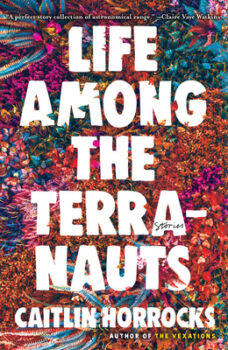 Very slow! The stories in the book were written over the course of nearly a decade, several of them while I was supposed to be working on a novel. I had no sense of building a book. I was just pursuing story ideas as they came, hoping individual stories would pan out, and then eventually, that I’d collect enough decent ones to form a second collection. I had a book’s worth of stories before I finished The Vexations, but my publisher decided to wait, and bring out the stories after the novel.
Very slow! The stories in the book were written over the course of nearly a decade, several of them while I was supposed to be working on a novel. I had no sense of building a book. I was just pursuing story ideas as they came, hoping individual stories would pan out, and then eventually, that I’d collect enough decent ones to form a second collection. I had a book’s worth of stories before I finished The Vexations, but my publisher decided to wait, and bring out the stories after the novel.
So not only did I write the individual stories over a long period of time, but I had to reenter and revisit the collection after the novel was finally done with all my fingers and toes crossed that it would still feel like a book I was proud of, and wanted to publish. Happily it did! I cut or swapped out a few stories for newer ones, and made some revisions to older stories, but I was mostly relieved that the book still worked, and still felt “relevant.” I mean, I don’t think anyone publishes short stories aiming to really cash in on the zeitgeist, but I was worried about the stories feeling politely mildewed. Worried despite the fact that I would never recommend “relevancy” as a conscious goal to anyone. I think as writers we have to trust that if the story you want to write is relevant to you, to your life and your preoccupations and your experience of being in the world right now, it’s going to be relevant to someone else’s, probably in ways you can’t fully anticipate.
“Politely mildewed!” Yes. I have that fear too, of material becoming outdated as I’m writing it. But your stories don’t read as outdated at all. And, the more fabulist pieces seem to allow for more space for contemplating our current times. Reading many of the stories, I had this surreal feeling of visiting these fictional places as an anthropologist from the future. Maybe this is because so many of the characters or narrators seem to be aware that they are living at the edge of something already going to ruin. How important is place to you when you first start writing a story? What kind of research do you do?
Years ago I was in Arles, France, for a single day, but I think about the place all the time. It was a Roman capital that became a provincial backwater and eventually a tourist town—Van Gogh did some painting there. It’s a lovely place, but one whose history is manifestly not an unbroken trajectory of growth or ever-greater success. In the United States, most of our towns and cities are young enough that we aren’t confronted with this in the same ways. Even where we have ruins, people outside those places can get away with thinking of them in voyeuristic ways, ignorant of the actual people who live there (I’m thinking first about the Detroit narratives I grew up with, but this is also true of other places). A lot of us don’t know how to talk about or live alongside our ruins. But I think we’re going to have to learn.
I research place in all the ordinary ways—travel and reading and maps and personal experiences and Google Streetview—and I don’t necessarily start with place as a key part of the story. There are stories in the book that are strongly rooted in specific spots, and others that could take place in any number of different spots. But something different about these stories from the ones in my first collection might be that I’m trying to think more intentionally about the history of places, about how living somewhere is also living inside its past iterations, and future possibilities, whether we’re consciously thinking of those or not.
You take on some heavy issues, although never in a heavy-handed way: global warming, race, immigration, ancestry, American privilege, wealth. We seem to be at a moment, at least culturally in the US, of significant change. Do you feel a responsibility to take on these subjects as a story writer? Has your process or your way of teaching writing changed in any significant way since you began teaching?
When I started graduate school I had a very reductive and wrong-headed sense of what “political fiction” meant. I bought into an artificial divide between literary craft and argument, something only privilege and ignorance allowed me to do. As a writer, I don’t feel a “responsibility” to write stories that tackle specific issues (I spent most of the Trump administration writing about turn-of-the-last-century composers and artists in France), but I do currently feel drawn to write about the world I’m living in, and that’s a world where the “heavy issues” you mention are pretty inescapable.
As a teacher, I started off giving advice that had been given to me, like italicizing words in “foreign” languages, whether or not they were foreign to the characters using them. I defaulted to an author-stays-silent workshop model. I’ve been moving away from that since I began teaching, and my workshops now are (I hope) dialogues where the author is a full and welcome participant. A workshop leader can do real damage when we demand that writers tell certain stories, or make their stories palatable and easily accessible to a certain readership. I try to come to the piece, not make the piece come to me. I’m sure I sometimes fail, but I try.
Which story in this collection was the one that was the most challenging to write for you? Why?
They were all hard in different ways. I think it’s possible to have a story show up as a gift, but it doesn’t happen to me often. I wrote “Teacher” in a couple of days, which is incredibly fast for me, but it emerged out of an anecdote an airport car service driver had told me five years earlier (and that I’d been thinking about periodically ever since—I chew on things like a cow). But if I have to pick one story as most challenging, I’ll say “Paradise Lodge.” It’s by far the longest story I’ve finished, and it has multiple main characters, all of whom are different from me in substantial ways. The characters were all challenging to get right on their own terms, and then challenging to play off of each other and balance with each other. Their interactions are shaped not only by who they are individually, but by their situation, in which money and geography and race and language and power all play a role. It’s a story I wrestled with for a long time, submitted it hoping I’d gotten things right, and then received a couple of kind “no”s that sent me back to try again. After acceptance, the editors at American Short Fiction (who were angels just to take a story this long) had good edits. Then, relatively late in the game, my editor at Little, Brown, Ben George, noted how the two kids were operating as a convenient unit, and wouldn’t it be better if they were separate actors? It would, so I headed back in one last time.
Your title, Life Among the Terranauts, is so perfect for your collection as a whole. There’s this sense with most of the major characters, almost of being a visitor on earth, a simultaneous awe and horror at the experience of being an earthling with all these other flawed and also beautiful humans. How did you settle on this as the title for the book as a whole? And why did you end with this particular story?
The more I talk about titles, the dumber I usually start to sound, because I tend to go about them in very practical ways. If I’m titling a story, I scan through the text looking for resonant phrases. If I’m titling a collection, I start with the table of contents and throw out the titles that would be obvious misnomers for the collection as a whole (“Norwegian for Troll,” for example, feels too specific for a book whose other stories involve neither Norway nor trolls).
Then I look through what’s left for a title I like on its own, and that suggests something about the flavor of the book as a whole. “Life Among the Terranauts” felt like the obvious frontrunner. But I remember placing it last in the book even before I was thinking of it as the title story. I’m trying to resist spoilers, but I’ll say the story ends on a sort of scorched earth moment. Any story collection requires the reader to shift gears over and over, between the endings and beginnings of different stories (something I personally enjoy but a lot of novel-preferring readers don’t). I felt like it would be asking a lot of the reader to leapfrog straight from the ending of “Life Among the Terranauts” into something else, and that the gears might grind.
What a perfect place to end this interview, Caitlin, with a reminder that so many of the choices we make as writers, as portentous as they may seem to readers, begin as practical problem-solving. Then again, what a magical thing a title is, that yours allows for the kind of trajectory you mention. Thank you so much for talking with me about these delectable stories.

